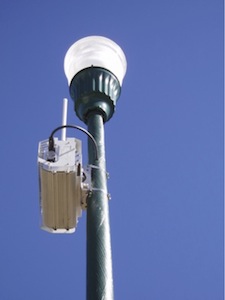
The retro look.
Every so often someone asks me something like why can’t we just use WiFi to deliver broadband service? For those of us who’ve been working in the community broadband sector for a decade or more, the question was settled with the collapse of the Great Muni WiFi Bubble more than ten years ago. But for most, that’s a relic of the distant and dim pre-iPhone past, when rocking good service was measured in kilobits and the fastest way to download a movie was to drive to a store and rent a video.
The answer is that WiFi technology was originally designed as an indoor substitute for short distance ethernet cables, and not for outdoor or wide area service. It uses unlicensed spectrum with power determined by federal regulations and propagation characteristics set by the laws of physics.
The primary factors that determine the practical service radius of a WiFi-based network are transmit power (again, limited by law) and antenna design and position. Other factors, such as foliage, interference/noise level and the limitations of the WiFi protocol, come into play, but raw power and antenna capabilities are the big ones.
So if you have a top of the line WiFi access point bolted to a light pole, using maximised omni-directional antenna design and transmit power, it can communicate at reasonably high speeds with a similar access point over something like 400 meters, assuming there are no major obstructions.
But if that access point is communicating through clear air with a laptop or mobile phone or similar mass market device, that effective distance drops to 100 meters or less. If there’s a wall between the device and the access point – i.e. the user is inside a home or business – the distance is considerably, maybe impossibly, less. The transmit power and antenna design of the user’s equipment counts, too. If the user has a special gizmo – a WiFi bridge with higher power and a better antenna – the effective range might go up as high as 200 meters, and it might be useable indoors. Might be.
But while might be is good enough for an occasional free connection to a hotspot, it isn’t an acceptable standard for mainstream, consumer grade broadband service. That’s why we need something better: appropriately designed, professionally engineered and sufficiently provisioned copper, fiber or wireless infrastructure.
